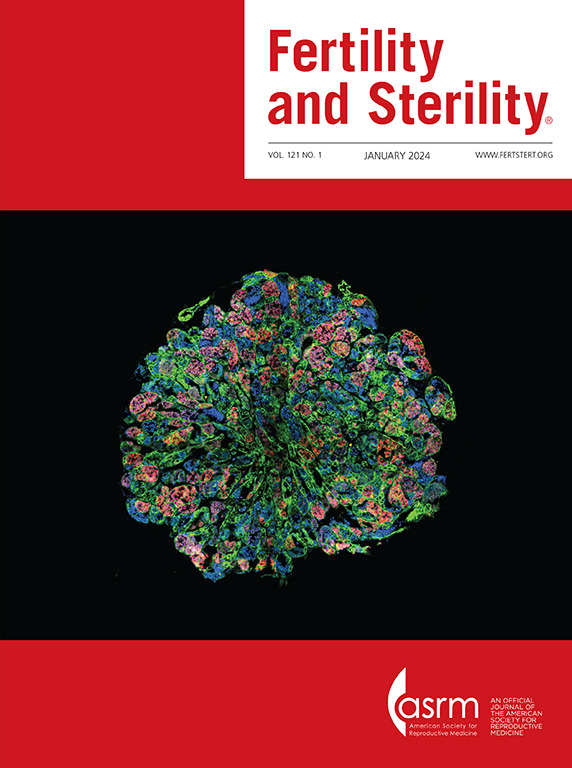INTRATESTICULAR AUTOLOGOUS PLATELET RICH PLASMA INJECTION IN COUPLES WITH NON-OBSTRUCTIVE AZOOSPERMIA: A NARRATIVE REVIEW.
IF 6.6
1区 医学
Q1 OBSTETRICS & GYNECOLOGY
引用次数: 0
Abstract
Azoospermia is the most severe form of male infertility presenting around 1% of the male population and 5%-10% of infertile men. Azoospermia is classified into two categories: obstructive azoospermia (OA) and non-obstructive azoospermia (NOA). Currently, micro Testicular Sperm Extraction (mTESE) is still the primary approach especially for cases with NOA. However, there are still some NOA patients in whom sperm can not be yielded even after repeated mTESE attempts. Besides, no definitive alternative treatments exist, prompting ongoing research into new approaches for restoring spermatogenesis in NOA patients. This review focuses on the current literature regarding the possible role of intratesticular autologous platelet rich plasma injection in couples with non-obstructive azoospermia. First, we give an overview of the pathophysiology of azoospermia and the sperm retrieval techniques in azoospermia. Subsequently, we give information about platelet rich plasma (PRP), and briefly discuss the role of PRP on ovaries and endometrium in the light of literature. Finally, we review the current literature on the testicular administration of PRP on animal models and on human. As a conclusion, the findings of the present review suggests that autologous PRP therapy shows promise as a novel approach in male infertility, especially for NOA patients. Nevertheless, additional investigation through randomized controlled trials is necessary to refine the technique and determine its effectiveness to answer the question of whether PRP could significantly improve the second attempt retrieval rate after a failed previous mTESE procedure.非梗阻性无精子症夫妇睾丸内自体富血小板血浆注射:叙述性回顾。
无精子症是男性不育最严重的形式,约占男性人口的1%,占不育男性的5%-10%。无精子症分为两类:阻塞性无精子症(OA)和非阻塞性无精子症(NOA)。目前,微睾丸精子提取(mTESE)仍然是主要的方法,特别是对于NOA病例。然而,仍有一些NOA患者即使在多次mTESE尝试后仍不能产生精子。此外,没有明确的替代治疗方法存在,促使正在进行的研究恢复NOA患者精子发生的新方法。本文综述了目前关于睾丸内自体富血小板血浆注射在非阻塞性无精子症夫妇中的可能作用的文献。首先,我们概述了无精子症的病理生理和无精子症的精子回收技术。随后,我们介绍了富血小板血浆(PRP)的相关信息,并结合文献简要讨论了PRP对卵巢和子宫内膜的作用。最后,我们回顾了目前关于PRP在动物模型和人类睾丸给药的文献。综上所述,本综述的研究结果表明,自体PRP治疗有望成为男性不育症的一种新方法,特别是对NOA患者。然而,需要通过随机对照试验进行进一步的研究,以完善该技术并确定其有效性,以回答PRP是否能显著提高先前mTESE手术失败后的第二次尝试检索率的问题。
本文章由计算机程序翻译,如有差异,请以英文原文为准。
求助全文
约1分钟内获得全文
求助全文
来源期刊

Fertility and sterility
医学-妇产科学
CiteScore
11.30
自引率
6.00%
发文量
1446
审稿时长
31 days
期刊介绍:
Fertility and Sterility® is an international journal for obstetricians, gynecologists, reproductive endocrinologists, urologists, basic scientists and others who treat and investigate problems of infertility and human reproductive disorders. The journal publishes juried original scientific articles in clinical and laboratory research relevant to reproductive endocrinology, urology, andrology, physiology, immunology, genetics, contraception, and menopause. Fertility and Sterility® encourages and supports meaningful basic and clinical research, and facilitates and promotes excellence in professional education, in the field of reproductive medicine.
 求助内容:
求助内容: 应助结果提醒方式:
应助结果提醒方式:


